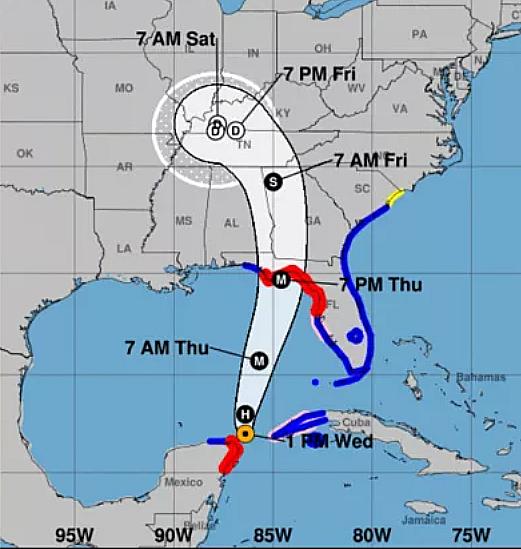
TALLAHASSEE, Florida, October 3, 2024 (ENS) – More than 200 people are dead and hope is dwindling that others will be found alive in the ongoing search for survivors of Hurricane Helene that blasted across the U.S. Southeast a week ago.
Over a million survivors are still without power and thousands are without clean drinking water and cell phone service. Falling trees crushed buildings as historic flooding across multiple states put homes and businesses underwater.
As search and rescue, power restoration and communication capabilities remain top priorities throughout the Southeast, FEMA has already helped thousands of Hurricane Helene survivors jumpstart their recoveries with more than $20 million in flexible, upfront funding.
More than 5,000 personnel from across the federal workforce are deployed, including more than 1,500 from FEMA. To date, FEMA has shipped over 9.3 million meals, more than 11.2 million liters of water, 150 generators and more than 260,000 tarps to the region.
President Joe Biden has approved a Major Disaster declaration for eight counties in Tennessee in addition to areas in Georgia, Florida, the Carolinas and Virginia. On Wednesday, the President announced an increase in federal cost share for each state up to 100% to help state, tribal and local governments and non-profit organizations cover the cost of recovery.

Climate change has made storms that originate over warming oceans and rising seas intensify more rapidly than before 1980, and “the proportion of Atlantic Ocean hurricanes that are Category 3 or above has doubled since 1980,” according to researchers at the nonprofit Environmental Defense Fund. For residents of the Southeast, Hurricane Helene meant record-breaking downpours with little time for communities to evacuate.
Category 4 Hurricane winds howled across Florida at 140-mph as Helene made landfall 11:10 pm ET Thursday near Perry, a small city 50 miles (80 km) southeast of the state capital Tallahassee in the Big Bend region where Florida’s panhandle and peninsula meet. So, Helene made history, becoming the first Category 4 storm to hit Florida’s Big Bend region since recordkeeping began in 1851.
Those who died in Florida’s Pinellas County were in neighborhoods where residents had been told to evacuate, said Bob Gualtieri, the Pinellas County sheriff. People who stayed because they didn’t believe the warnings wound up hiding in their attics to escape the rising water, he said.
“We tried to launch boats, we tried to use high-water vehicles and we just met with too many obstacles,” Gualtieri said. He said the death toll could rise as emergency crews go door-to-door in the flooded areas.
Ninety shelters are open throughout the state, including two state-operated shelters in Tallahassee and DeFuniak Springs. These shelters are housing over 4,700 residents from areas affected by Hurricane Helene.
Florida Governor Ron DeSantis has declared a state of emergency for 61 counties, which allows state officials to make critical resources available to communities ahead of any storm impacts.
Residents needing assistance finding or going to a shelter in the Big Bend region for Hurricane Helene can call (800) 729-3413.
Florida Division of Emergency Management team members are conducting callbacks from messages received last night and accepting new calls today to facilitate shelter coordination. For additional resources and assistance, residents can call the State Assistance Information Line, SAIL, at 800-342-3557. Assistance is available in English, Spanish, and Haitian-Creole.
Georgia Was Next
Hurricane Helene then blew north from Tallahassee, still packing the Category 4 strength winds and then gradually weakened to a Category 1, still with dangerous winds of at least 75 mph.
Valdosta, a university town in southern Georgia, just north of the Florida border, was among the first places in that state hit by Helene.
“Thank God we’re both alive to tell about it,” Rhonda Bell told the AP in Valdosta after a giant oak tree crushed her roof.
In Tallahassee, Georgia Governor Brian Kemp told reporters Friday morning that dozens of people are still trapped in buildings damaged by the hurricane. First responders are racing to rescue as many as they can.
“This has been a deadly storm. We’ve had 11 confirmed fatalities,” Governor Kemp said. “We know that one of those was a first responder. When we ask people to stay off the roads and be patient. It’s because we are trying to get to people. It is a very dangerous environment and one of our finest has lost his life trying to save others.”
“We’re also trying to get the multiple structures right now that we know have individuals inside that we’re unable to communicate with. We’ll have to literally cut our way into situations like this,” the governor said.
He gave a thankful shout out to the Maryland Search and Rescue team who came to Georgia to help them in this emergency.
“Early this morning, we had wind gusts over 90 miles an hour that were measured in South Georgia as a Category 2 hurricane. Actually 100 mile an hour wind gusts were measured in Alma, Georgia and Bacon County at this time.”
The governor said that Valdosta has identified 115 structures that are heavily damaged “that we know there are multiple people trapped inside.”
“Again, we just want to urge people especially in those areas to be patient. We have a lot of people calling us because they may have a tree across their road and their neighborhood may be may be, may be blocked. But our priority is getting to medical emergencies and facilities like hospitals, nursing homes and others that need critical help and don’t have power,” Governor Kemp said.
South Carolina Not Spared
In Columbia, South Carolina, the state’s capital city, Governor Henry McMaster briefed reporters this afternoon. At the height of the storm, wind gusts in the state ranged from 50 to 70 miles per hour, the wind speeds of a Tropical Storm.

Even so, Helene caused at least 13 deaths in South Carolina as its winds covered the state early Friday and left more than 1.2 million homes and businesses without power statewide, the governor said.
McMaster said two firefighters died in Saluda County and two people died in Newberry County in traffic-related incidents caused by the storm. High winds uprooted trees from soils already saturated after days of rain, he said.
Utilities statewide reported outages, including Dominion Energy, Duke Energy, Santee Cooper and the state’s electric cooperatives. Executives from the power companies said some outages could last through the weekend and into next week.
Jimmy Stanton, head of the state-owned utility Santee Cooper, said most of the power company’s issues were with its major transmission lines that supply electricity to South Carolina’s electric cooperatives.
Speaking for the state’s 19 cooperatives, Central Electric Power Cooperative CEO Rob Hochstetler said the storm snapped several hundred poles and tore down power lines. Cooperative employees who have been in the business 40+ years reported Helene was the most destructive storm they had ever seen.
Trees fell on the trucks of two crews while they were out trying to restore power, Hochstetler said. No workers were injured.
John Quagliariello, a National Weather Service meteorologist reported rainfall totals of 15 inches in Oconee, Greenville and Pickens in the days before the storm. The National Weather Service issued numerous tornado warnings but Quagliariello said it’s still unknown how many tornados actually happened.
Utility executives stressed the importance of staying away from downed power lines, and state Fire Marshall Jonathan Jones reminded residents to use caution should they choose to run a generator.
He said generators should not be run inside homes or attached garages and should be kept away from doors, windows and other openings to prevent the potential for carbon monoxide poisoning.
All authorities issue warnings similar to this one from the Georgia Emergency Management and Homeland Security Agency, “In case of flooding, do not drive or walk through standing water or drive around barricades. Stay away from downed power lines to avoid the risk of electric shock or electrocution. If a tornado warning is issued, storm cellars or basements provide the best protection. If an underground shelter is not available, go to a small, windowless interior room or hallway on the lowest floor possible.”
Dominion Energy South Carolina President Keller Kissam told the briefing, “Life’s not going to be back to normal until probably the middle of next week from a power standpoint, just because of the sheer damage that we have.”
For those displaced by the storm, the state has six shelters open across Laurens, Orangeburg, Oconee, Pickens, Saluda and Spartanburg counties. So far, only about 30 people have sought shelter, said S.C. Department of Social Services Director Mike Leach.
Over the weekend, Quagliariello said the National Weather Service is forecasting major river flooding on the Saluda River near Greenville, the Broad Rivers near the North Carolina border and the Wateree River near the dam.
The South Carolina Department of Environmental Services Interim Director Myra Reece said her agency is communicating with officials in North Carolina monitoring the Lake Lure dam that, if it were to breach, could impact South Carolina.
Heavy rainfall from Helene has threatened the dam at Lake Lure, the National Weather Service warned. Lake Lure is in Rutherford County about two hours drive west of Charlotte, North Carolina.
Lake Lure was made famous by the 1987 movie “Dirty Dancing,” as the Lake Lure Inn’s ballroom provided the setting for the final pivitol dance scene. The lake and surroundings have also been the setting for 11 other films, including “Firestarter,” and “Thunder Road.”
Friday morning Lake Lure officials told Rutherford County Emergency Management that they expect water will spill over the Lake Lure Dam. Evacuation orders were issued at once.
Storm Smashes North Carolina
As a Tropical Storm, Helene blew into North Carolina, where Governor Roy Cooper told reporters this morning that emergency responders are delivering trapped residents to safety while coping with power outages and flooded roadways, particularly in western part of the state as the storm’s track bends west toward Tennessee.
“The priority now is saving lives,” Governor Cooper said. “Helene is causing life threatening flash flooding, numerous landslides and down trees causing power outages. Flooding will continue through the weekend in some areas and may even occur in areas that don’t typically flood with the rain that they had already been experiencing before Helene’s arrival.”
“Sadly, our hearts are heavy as we report two deaths, one in Catawba County due to a motor vehicle collision on a flooded roadway and one in Charlotte due to a tree falling on a home. There will be more as we know this storm is continuing across our state. We are working to try to prevent as many as we possibly can and in all parts of our state where there is flooding,” the governor said.

“This is one of the worst storms in modern history for parts of western North Carolina. The end of the rain is not the end of the threat. This fierce storm will move out of our state in the next 24 hours but the danger will not be over tropical storm force winds that border on hurricane strength are happening right now across western North Carolina, trees are falling, causing widespread power outages,” Cooper said.
Throughout the weekend, North Carolina search and rescue teams are being assisted from teams from more than a dozen other states and I’m deeply grateful for their work to save lives.
As of this morning, there are over 879,000 estimated power outages across our state. We’re also currently aware of 290 closed roads. For the people in western North Carolina – do not travel unless there is an emergency because conditions are continuing to worsen, the governor warned.
“People in western North Carolina should consider all roads closed unless you are seeking higher ground for much of our state. There’s also the continued potential for net tornadoes with the storm system, they can quickly spin up with a little warning. I urge people to stay informed, listen to local radio TV and local emergency response officials.”
Cooper said, “Remember do not drive through floodwaters, as I’ve said so many times, we’ve lost too many North Carolinians who’ve driven into floodwaters. So turn around, don’t drown.”
“Currently, we’re aware of over 100 swift water rescues since the beginning of this event, but we know there will be many more our emergency management team here and in counties across the state are continuing to deploy resources strategically to save lives and to strengthen the response for counties and cities. Numerous evacuations have been ordered in areas likely to flood if you’re told to evacuate, please get out of the danger zone,” the governor said.
There are about 15 shelters available in North Carolina, and more will be added. We know North Carolinians are strong and our first responders are the best in the nation. I’m thankful for their hard work and for risking their lives to protect all North Carolinians.
More and Stronger Storms Forecast
“Scientists expect that the rapid intensification of hurricanes will continue in the future unless drastic measures are taken to limit further climate change,” Fiona Lo, a climate scientist with the Environmental Defense Fund, EDF, says.
The Environmental Defense Fund puts its hope for resilience in the restoration of nature where it has been degraded.
“The most cost-effective protection we have against hurricanes is restored natural infrastructure: the coastal marshes and forested swamps known as wetlands, plus the barrier islands and oyster reefs found in some coastal landscapes,” the EDF advises. “Coastal wetlands are a double whammy against super storms because they absorb and store carbon from the atmosphere to stabilize the climate, reducing flood risk, while also slowing and lessening storm surge, reducing flood damage.”
Featured image: Pinellas County Sheriffs search a ruined home for sheltering residents trapped by Hurricane Helene. Pinellas County, Florida, September 27, 2024 (Photo courtesy Pinellas County Sheriffs Department via X)
© 2024, Environment News Service. All rights reserved. Content may be quoted only with proper attribution and a direct link to the original article. Full reproduction is prohibited.



